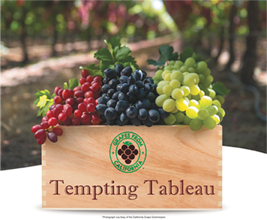Louie Galvan of Fruit Royale, Inc., headquartered in Delano, also concedes that even with the record harvests, “The last two years have been challenging due to the drought. The future depends on the amount of fresh water available to us in order to sustain growth.”
Of course, none of these challenges are new to the industry. Bari Produce’s Bedwell says, “California has many challenges that need to be addressed if the future is to remain bright for table grapes. Chief among them are water supply and costs; labor and immigration issues; state and federal regulations; invasive pests; and healthcare mandates.”
FRESH FORUM
Have you made any major changes in how you plant, grow, or harvest your grapes?Jared Lane – Stevco, Inc.
Variety selection: these are changing every day. Also, there are new materials to better the product like new fertilizers and sprays to battle mildew.John Zaninovich, Vincent B. Zaninovich & Sons, Inc.
Over the years, trellis systems have changed to make the grapes easier to pick and produce bigger yields. We’ve also implemented advances in irrigation—now it can be more precise so we can be more conservative with water. But some things haven’t changed in years—stick a piece of wood in the ground and hope for the best.Justin Bedwell, Bari Produce, LLC
We’ve been investing in drip irrigation the past 10 to 15 years, and all our grapes are watered by drip now. We’ve also been working on proper trellis systems tailored for each variety that allow the vines to hang in such a way for good air movement.Jon P. Zaninovich – Jasmine Vineyards, Inc.
Over the years we’ve changed the way we plant by putting in disease-resistant root stock instead of natural roots. The use of trellises has evolved for ease of picking and to make vines more productive. We’ve also gone to pouch bags, which offer more real estate for point-of-sale merchandising, and are more convenient for consumers.
Peeking into the Future
The consensus in the table grape industry is that despite concerns about water availability and other obstacles old and new that come with agriculture, the future still looks positive.
Lane sees “slow, steady growth in box count. We’re planting new varieties that taste better and can be grown at the lowest production cost. Every time we plant a new variety, we have to learn about how it grows and stores—this can take years of development to find the correct balance. New varieties are a big gamble.”
Anthony Vineyards’ Harley also sees continuing growth. “I think our industry will continue to increase; 2014 was down a bit from 2013 due to some changeover in varieties. Old ones were taken out, and newer put in. Established Thompson vineyards that have reached maturity are being replaced by seedless red varieties like Flame, Timson, Timco, and Majestic. Some of the newer ones including Luisco and Autumn King are stretching the harvest through November and December, when in the past we relied on stored grapes to get through the late fall.”
Bedwell’s take on the future is ‘bigger and better’—“Our industry will get bigger. More grapes are going in the ground and all the newer varieties have great production and acre yields.”
Fruit Royale’s Galvan remarks, “As demand grows, so will our industry. The growth is not only domestic, but on an international scale, too. We expect a 20 percent increase in tonnage in the next five years.”
Photograph courtesy of the California Grape Commission.



